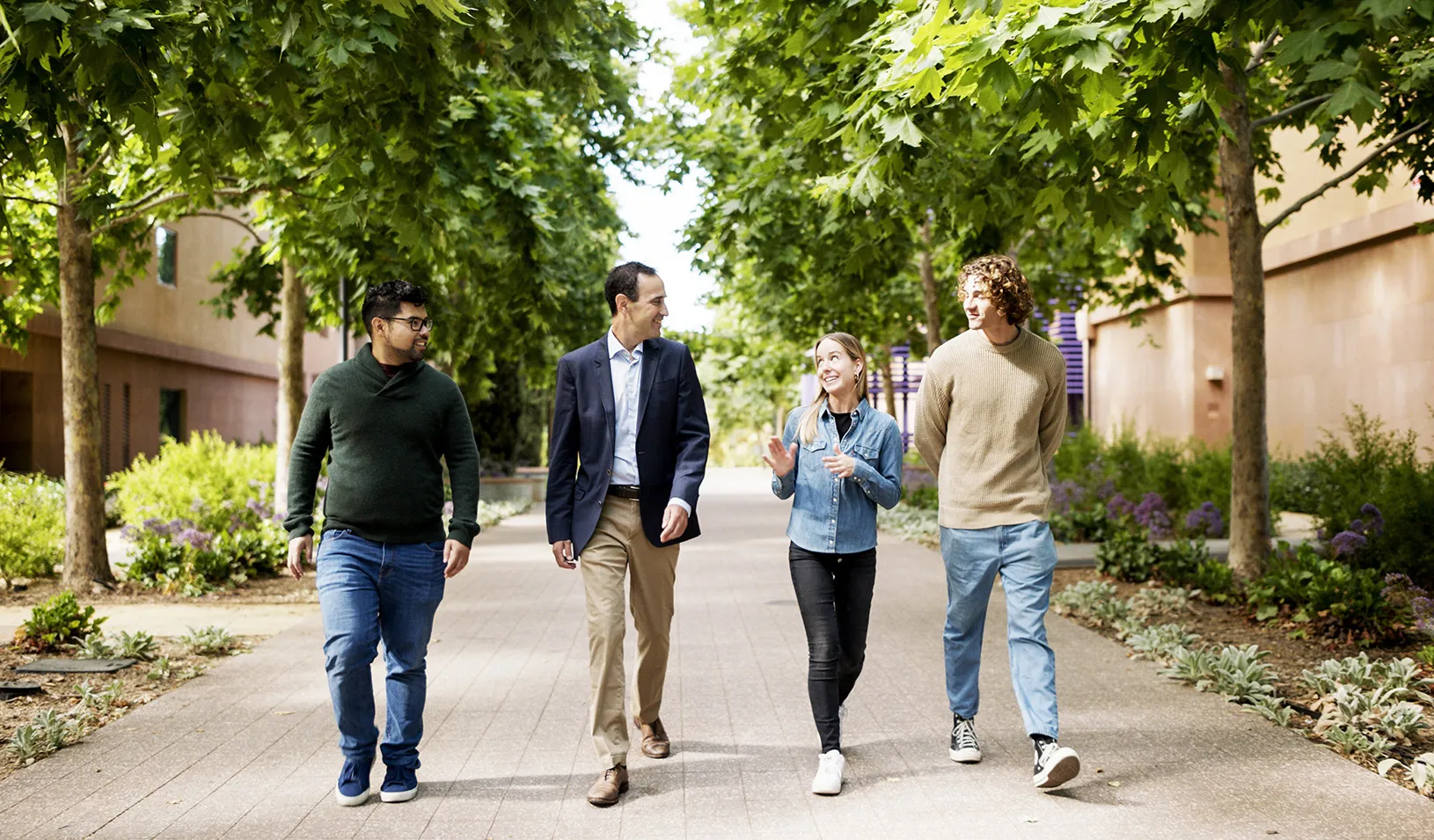Stanford GSB Knight Management Center to Achieve Highest Green Level
New facility is expected to earn the highest LEED Platinum rating for environmental sustainability from the U.S. Green Building Council.
April 19, 2011
On April 29, 2011, Stanford Graduate School of Business opens the Knight Management Center, a new facility of eight buildings around three quads designed to support an innovative MBA curriculum put in place in 2007. The center is expected to achieve the highest LEED Platinum® rating for environmental sustainability from the U.S. Green Building Council.

The Knight Management Center generates 12% of its energy needs through photovoltaic panels mounted on the roofs of its buildings.
“The best buildings in the world derive from a clear sense of what people want them to become,” said Stan Boles, principal architect for Boora Architects, which also designed four environmentally sustainable buildings in the new Science and Engineering Quad at Stanford. “We were inspired by the Stanford Graduate School of Business vision for educating the world’s future leaders. Innovation and collaboration are paramount.”
Together, the Knight Management Center and the adjacent Schwab Residential Center for MBA students and executive education participants foster interdisciplinary learning and demonstrate the commitment of the Stanford GSB to environmental leadership. Construction of the Knight Management Center further leverages Stanford University President John L. Hennessy’s call for the university to be a force for change on issues of global importance, especially regarding the environment.
Filled with light and the latest technology, the 360,000-square-foot facility underscores what is taught in many of the Stanford GSB’s electives such as Environmental Entrepreneurship and Environmental Science for Managers and Policy Makers, as well as in core classes covering sustainability across the functions of business, and in its MBA/MS Environment and Resources joint degree program.
Green aspects of the building that contribute to its high sustainability rating include:
Lighting
The relatively narrow dimensions of the classroom buildings and floor-to-ceiling glass maximize the amount of daylight entering the building, significantly reducing the need for electric lighting. 90% of interior work spaces are illuminated by daylight and room lights turn off automatically when a room is emptied, reducing the electricity load.
Energy
Photovoltaic panels on the roof will generate 500,000 kilowatt hours per year, harvesting enough solar energy to power 12.5% of the complex’s energy demand. The Knight Management Center’s eight buildings will exceed current state energy standards by 45%. For example, more efficient under-floor air distribution systems replace forced air systems, and air-handling units recapture waste heat and redistribute it where it is needed. During summer months, the building will employ night flushing systems-automated skylights and windows-to release the hot air of day and draw in cool air overnight.
Water
The center will use rainwater or re-circulated gray water to reduce potable water usage for sewer conveyance by 80%. Landscape plans were developed with sustainability in mind.
Open Space and Vegetation
More than 60 trees were removed from the site, boxed during construction, and then replanted at the center. Wisteria vines climb up the roof-like trellis surrounding the circular Arbuckle Dining Pavilion, allowing for shaded outdoor dining outside. Trees line a path along Knight Way, which draws the rest of the Stanford campus into the business school area. Stanford uses native and drought-tolerant plantings to reduce the need for irrigation. This tradition is continued at the Knight Management Center. Fifty percent of the site is devoted to open space.
Building Materials
The Arbuckle Dining Pavilion uses a radiant floor heating and cooling system. Recycled materials are used extensively. Use of low or no volatile organic compound-emitting materials throughout the buildings ensures exceptional indoor air quality.
Built across the street from the beautiful Schwab Residential Center for MBA students and executive education participants, the Knight Center design fosters an integrated living and learning environment. Indoor and outdoor spaces seamlessly blend with walls that fold open to the outside for increased interaction in social areas including the circular Arbuckle Dining Pavilion. All parking is underground.
Stanford’s Sustainable Master Plan Legacy
Frederick Law Olmsted’s master plan for Stanford University, developed in the late 1800s, set the Main Quad as the dominant feature of the campus. For the 21st century and beyond, Stanford has embarked on a mission to build on and restore the original master plan by reinforcing Serra Street as the primary east/west axis for the campus. Placing the Graduate School of Business at the east end of Serra Street, with the School of Medicine at the west end, strengthens the importance of Serra Street as the primary campus link.
This east/west axis is also the ideal orientation for sustainable building design. The Knight Management Center takes advantage of the southern exposure to reduce the need for artificial lighting, while the long north orientation allows the buildings to take advantage of the Mediterranean climate through the use of operable windows providing natural ventilation to many interior spaces.
For media inquiries, visit the Newsroom.
Explore More
Erin Nixon Joins Stanford GSB as Assistant Dean of Admissions

Nia Rose Froome, MBA ’23: Making Local, Fresh Food Available for All

New Research Fund Promotes Responsible Leadership for the Next Century
